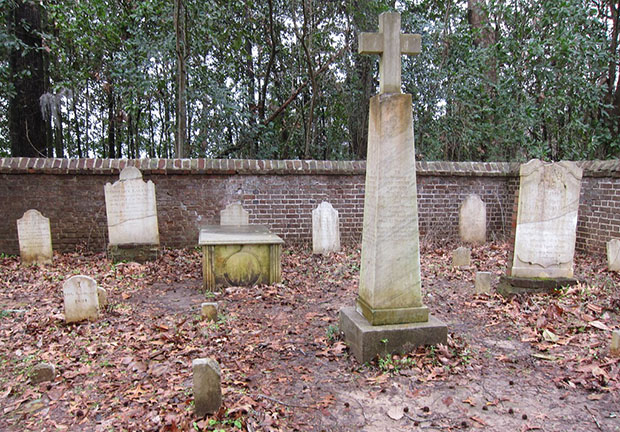The Final Rest of Henry Laurens
05 Sep 2021
The dramatic first cremation of a political figure
By Tim Lowry
Photo by Elizabeth Duran Gessner

As a professional storyteller, I am often asked to tell spooky stories at fall gatherings, which is to be expected with Halloween. I enjoy telling these type stories except for one thing: whether I am telling to teenagers around a campfire, to tourists in a local farm’s corn maze, or to diners at an upscale restaurant, there is always that one person complaining that my story isn’t scary enough. It isn’t edgy enough. It isn’t ghoulish enough. When that one person lodges their complaint, I take them aside and tell them the following true tale…
In the spring of 1760, the dreaded plague of smallpox threatened the lives of people young and old across the South Carolina Lowcountry. There was plenty of debate as to whether inoculations were effective in fighting the disease. (Hmm…the more things change, the more they stay the same.)
Mr. Henry Laurens, a native of Charleston, who served as president of the Continental Congress and prominent plantation owner with a spread of 3,000 acres on the Cooper River (in what is today known as Mepkin Abbey Moncks Corner), undoubtedly heard the arguments for and against inoculation, but all that talk seemed like vain babbling in his ear, because his infant daughter, Martha, had succumbed to the horrible disease.
As was common practice for the times, her little body was laid out on a bed beneath an open window. Henry and Eleanor, his wife and the child’s mother, and presumably other members of the household, brought chairs into the death room to commence with the wake.
Separate accounts of the story vary, but as I read it…
A light rain began to fall. A soft breeze blew the rain through the open window and when cool droplets landed on the child’s head, she began to stir! Little Martha had—clearly—not passed. Talk about a gross misdiagnosis! The dreaded mistake of accidentally burying the child alive was narrowly avoided. As it turned out, Martha had a full recovery, grew up, married Dr. David Ramsay, and lived a full and productive life.
However, the thought of accidentally being buried alive completely unnerved Mr. Henry Laurens.
Consequently, in his last will and testament (a copy of which is on file in Charleston County’s Main Library in Will Book B), Mr. Laurens wrote very specific instructions: “I come to the disposal of my own person. I solemnly enjoin it on my son [Henry Jr.] as an indispensable duty, that as soon as he conveniently can after my decease, he cause my Body to be wrapped in twelve yards of tow cloth, and burnt until it be entirely and totally consumed. And then collecting my bones, deposit them where ever he shall think proper.”
How exciting! We had never had a cremation in the state of South Carolina before! Cremation, widely accepted nowadays, was at that time considered a vulgar and undignified way to be ushered off to your eternal reward. It smacked of the superfluity of heathen naughtiness.
Henry died in December of 1792. However, the family did not dispose of his remains for a full three days. I can only speculate, but assume that this 72-hour interval allowed for plenty of time for a potentially reviving rain, the checking for breath with a mirror, and/or the administration of a red hot poker.
At any rate, on the appointed day, a funeral pyre was erected on the banks of the Cooper River. Mr. Laurens’ mortal remains were laid atop and a flaming torch was touched to the tinder.
Again, multiple accounts of the story include or exclude certain details, but as I heard it in a retelling . . .
The fire burned high and hot. However, the human body is largely composed of water, and an unexpected quantity of liquid dripped down upon the wood and extinguished the flames. All of a sudden, Mr. Laurens’ head broke loose from the remainder of his corpse and with hair aflame, rolled down the river bank, into the water, fizzling out among the reeds. Some poor enslaved servant was required to extract the head from the pluff mud so that it could be buried with the rest of the charred remains at Mepkin Plantation.
Needless to say, the practice of cremation as a socially acceptable form of funerary custom suffered a tremendous setback. While this marked the first cremation of a major political figure in the United States, it would not be widely practiced until the later half of the twentieth century.
As for Mr. Henry Laurens, his head and whatever else was left of him, are interred near the place of the infamous cremation site. The property once known as Mepkin Plantation is now Mepkin Abbey. However, if you visit the monastery, due to their vow of silence, the Trappist monks residing there will most likely decline to relate the above horror story. And outside of the occasional Halloween fright night, I think that is for the best.
The grave of Henry Laurens and family can be viewed along with the sprawling grounds at Mepkin Abbey, which is now run by St. Benedict Trappist monks, who devote their lives to prayer, spiritual study, work and hospitality.
Storyteller Tim Lowry is a Southern raconteur from Summerville. Learn more at www.storytellertimlowry.com.












